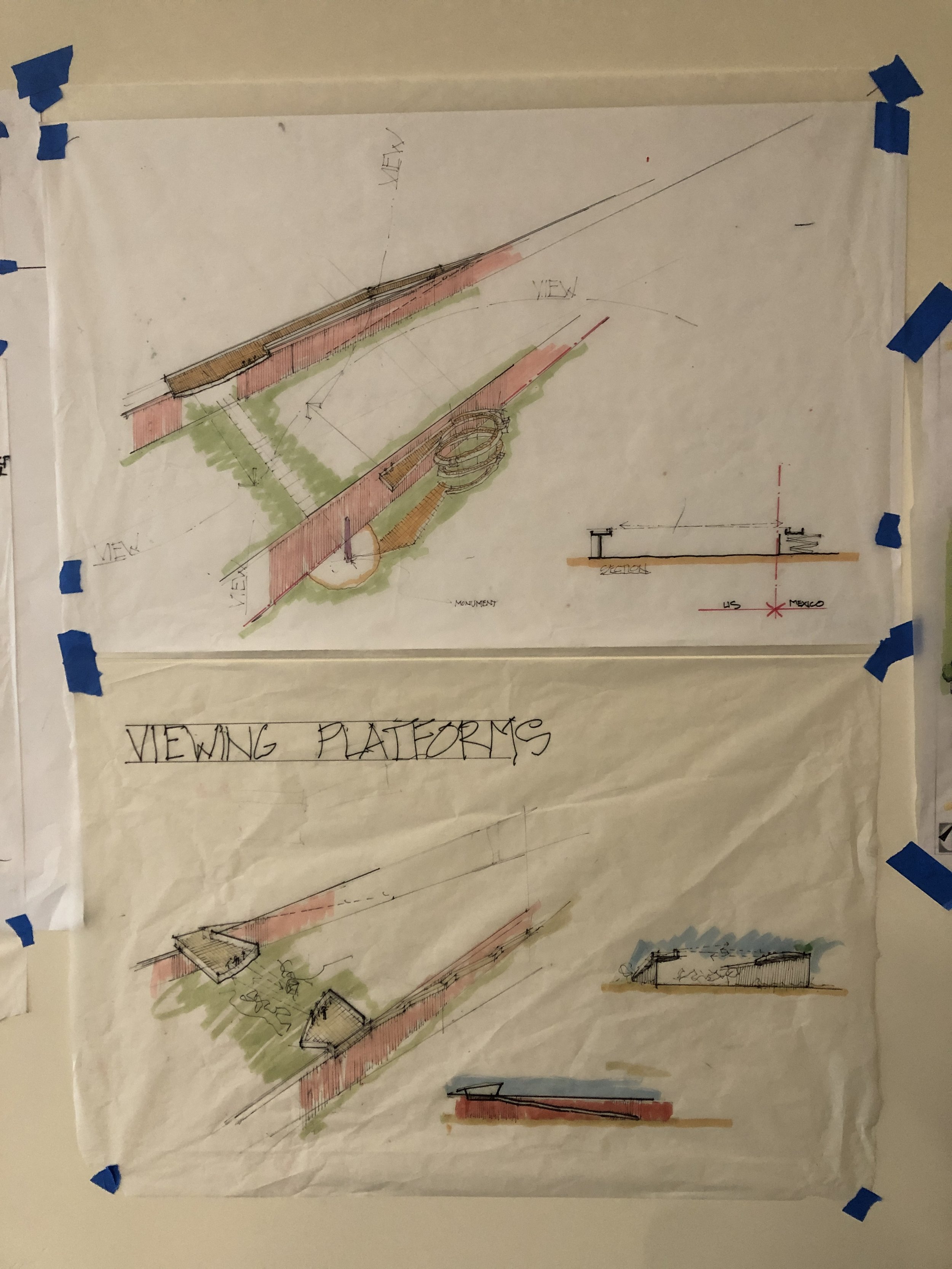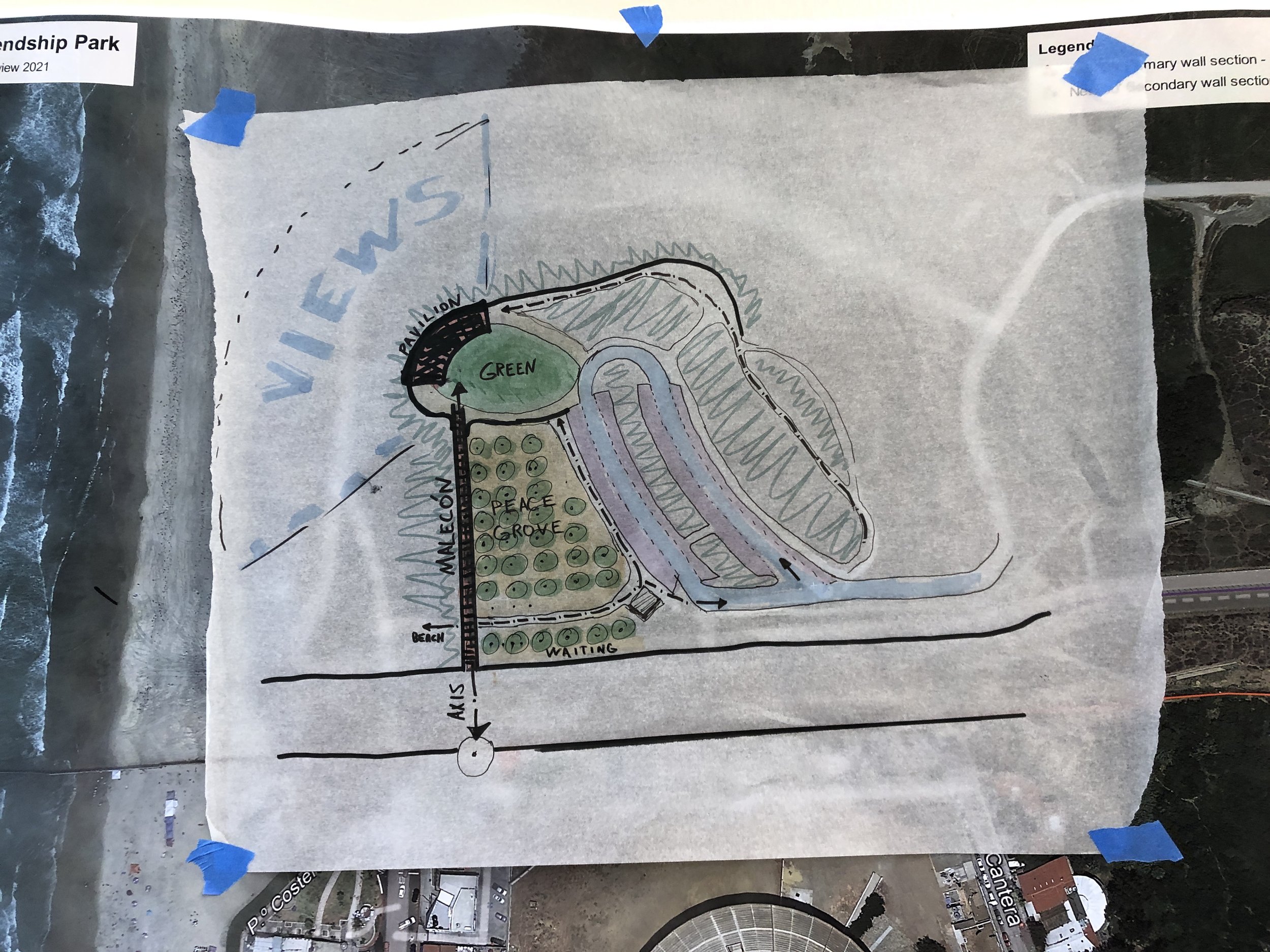A New Vision for International Friendship Park
From east to west, the US/Mexico border runs through river, desert, and mountains before it dives into the waves of the Pacific Ocean. At this junction between two nations and the sea, the land rises gently to a point known as Monument Mesa. This is the site of International Friendship Park, a public space that straddles the border, and for years has allowed people to reconnect with loved ones. If you’d like to get caught up to speed on the history and meaning of the park, there’s a quick slideshow here.
Sadly, Customs and Border Protection (CBP) shut down the U.S. side of the park in February 2020. In September 2022, the community organization Friends of Friendship Park set up talks with CBP to discuss a path towards re-opening the park. Our Senior Associate, Benjamin Arcia was a participant in this two-day summit that involved opening a dialogue with federal officials, creating conceptual design studies for a re-envisioned park, and collecting input from local leaders. This is his report on the two-day summit:
Day One: Meet with CBP
CBP Presentation
Day one’s dialogue started with a presentation by Customs and Border Protection (CBP). CBP officials shared the history of the border barrier and listed the operational requirements they wanted to fulfill by extending the existing eighteen-foot-tall fence to thirty feet, per the design approved by the Trump Administration.
Based on data collected in other border areas where the 30’ fence has been installed, a taller fence means fewer people trying—or succeeding, to get over. In CBP’s eyes, a taller barrier leads to more favorable outcomes. Our team pointed out that there is a proven higher mortality rate associated with the taller wall. People still try to climb, but now they fall from a deadly height. How many deaths justify a lower recorded attempt rate?
In the image below, the current 30’ tall fence stops before reaching the bullring in Tijuana. From this point on, it runs 18’ tall into the ocean. The visual impact of heightening this section would be undeniable. Extending this monolithic barrier to the beach that for decades has been a place for connection would be a symbol of the US turning its back to its neighbors.
Friends of Friendship Park members emphatically opposed increasing the wall height. Instead of negotiating a path towards a re-opened park, CBP was instead fixated on creating a more physical barrier between the two countries. Discussion of the park itself was limited to a few questions about rolling gates and meshes. Frustrated with CBP’s opacity and unwillingness to listen, we came away from the morning’s meeting with two goals:
Promote public opposition to a taller fence.
Envision a new version of Friendship Park that people will rally around.
Multi-disciplinary Brainstorm
After the meeting, our group’s facilitator Robert Lane helped us identify the objectives, policies, programming, and design interventions that we would focus on over the next two days. As a group of mostly designers, we shifted our efforts towards devising design solutions that would advance our key priorities: (1) attract people to the park, and (2) ensure a beautiful, dignified experience while there. We split apart for individual work and reconvened some hours later to share ideas.
Landscape Architect Michelle Landis presented a landscape plan for International Friendship Park. She envisioned the space between the two fences as a series of circles of different sizes. A circular meeting plaza, a circular native garden, and circular clearings for picnics and family gatherings.
The circle motif implies that the people of San Diego and Tijuana are one whole divided by a line. Michelle’s proposal builds on the existing circles of planting and hardscape from the original Friendship Park that survive on the Mexico side.
Architect Jim Brown focused on the connection between the ocean and the proposed, renovated Friendship Park. He designed a path that meanders down from Monument Mesa to the beach. At the beach, Jim envisioned an area for folding chairs for shared relaxation on both sides of the border.
Jim also studied a few alternatives for fencing details that could conform to CBP’s operational requirements while allowing visitors to have meaningful connection through the barrier. What could the experience be like with plexiglass, steel mesh, or movable panels?
Rob Lane proposed a few studies of monumental, elevated platforms that would provide an unobstructed view across the space between the fences. CBP ultimately rejected these ideas, but it was helpful to study some more ambitious schemes to discern the edges of CBP’s comfort zone.
While my teammates focused on the space between the two fences, I decided to study the larger picture. To the north of the federally controlled zone, California State Parks owns and manages the majority of Monument Mesa. The current park amenities are subpar. What if we team up with California State Parks to redevelop the park and bring it to life? With more eyes on the space, more people enjoying it, perhaps we can build pressure on CBP to turn the space between the fences into something that serves the community.
This new vision for Monument Mesa features an event green, a pavilion with views of downtown San Diego, a boardwalk overlooking the dunes, and a peace grove of trees that provide shade and tranquility. This simple layout builds on the existing park in a way that is impactful and sets the stage for visitors to have lifelong memories tied to the space.
Community Feedback
Later that afternoon, we collected feedback from local leaders in design, community organizing, and cross-border issues. We were happy to see that our initial ideas were received positively, and we ended the first day feeling encouraged about the effort that lay ahead.
Day Two: Creating a Vision
Our mission on Day Two was to bring our disparate ideas into one cohesive vision that we could share with Customs and Border Protection. We had a meeting scheduled with them for the afternoon, so the clock was ticking to create sketches, diagrams, and even some renderings in just half a day.
I was grateful for this opportunity to use my modeling and rendering skills to help the cause. In just a few hours, I assembled a loose massing model depicting our design, the border fence, and the surrounding context.
The event green offers wide views of the Coronado Islands and downtown San Diego.
A boardwalk leads us past the Peace Grove to the border monument, erected in the late 1800’s.
Friendship Park is seen here restored, featuring a new walkway that connects it to the sand, shade trees and picnic areas sprinkled throughout, and a re-planted bi-national native garden.
Sharing the Vision
As the afternoon rolled in, so did some of our guests from the previous day. We spoke with representatives from Customs and Border Protection (CBP) and San Diego Border Patrol for more than an hour. After presenting our design visions for the new park, our guests also weighed in, explaining the importance of the park and the different ways in which the park has served people on both sides of the border. As our dialogue concluded, CBP expressed a desire to work with us towards a mutually beneficial outcome. They said they were going to collect public input and deliberate towards a solution. Friends of Friendship Park started a letter-writing and signature-collecting campaign.
However, some weeks later they announced that they were indeed going to heighten the fence to 30’. Customs and Border Patrol’s previous enthusiasm for public input did not translate into any substantive change in their plans for the border fence. This was deeply disappointing news, and Friends of Friendship Park is taking the fight to higher levels within the Executive Branch. There is no certain indication of CBP yielding on this issue yet.
Fence height notwithstanding, CBP did confirm that they would eventually allow for Friendship Park to reopen. No timeline, no budget, just the intent to let it exist once again.
So here we are, at the beginning of a new life for International Friendship Park. The path forward is a bit foggy, but optimistic. We have an exciting design vision, we have involvement from some of the region’s top design talent, and Friends of Friendship Park has assembled an alliance of local, state, and federal elected officials that support the effort.
If you’d like to get involved, please start with this petition here, and then click here to stay up to date with the evolving effort. With your help, we will build that park.
Benjamin Arcia, ASLA, M.U.D.
Senior Associate
David McCullough Inducted into San Diego Chapter of Lambda Alpha International
David McCullough pictured with Jon Schmid, President of the San Diego Chapter of LAI at the induction ceremony.
LAI to Leverage McCullough’s Land Use Expertise
David McCullough, ASLA, PLA, has been selected to join the San Diego Chapter of Lambda Alpha International (LAI). Each year, a hand-picked group of professionals who have distinguished themselves in disciplines relating to the use and re-use of land is invited to become members of the land economics organization. A high honor, David McCullough’s invitation to LAI membership reflects his significant impact on San Diego’s built and natural environment.
Daniel Reeves, Past-President of the San Diego Chapter of LAI, states,
“We congratulate David—and all of our inductees in the LAI class of 2023. We’re excited to see how our group dynamic will be enhanced with the addition of these industry experts.”
LAI’s diverse membership provides talent, knowledge, and expertise to leverage for educational programs and discussions. The 2023 class of inductees includes 18 new members, the largest group in the history of LAI’s San Diego Chapter. David and Catherine attended the induction ceremony on Saturday, February 18th.
Photo by John Newsome
David McCullough states,
“Being a part of LAI will allow me to both contribute my knowledge and be enriched by the expertise of others. I’m honored to join this elite group of professionals.”





Congratulations to Adam Crowell on his Promotion!
Adam was recently promoted to Associate Landscape Designer and Project Manager. He began at McCullough in 2021 as a Junior Associate. Adam’s role as a landscape designer and project manager is to listen to our clients and translate their vision into public spaces that everyone can enjoy for years to come. He feels the need to help create spaces that leave an impact on people, and he feels fortunate to be part of a collaborative and curious team with such great talent. Taking on this bigger role in project management is something that Adam is excited about because it means he gets to work closer with clients and achieve greater results together. We are so proud of him!






















